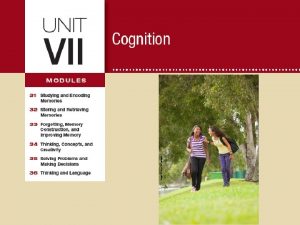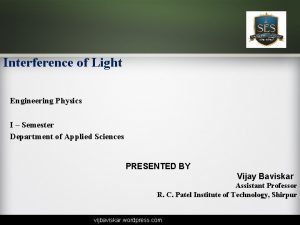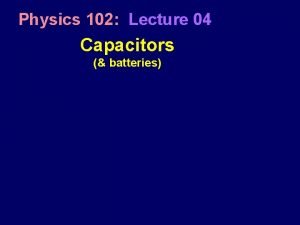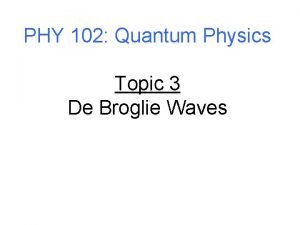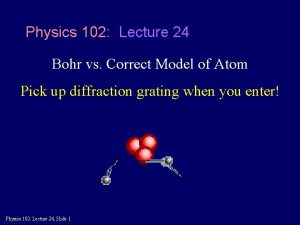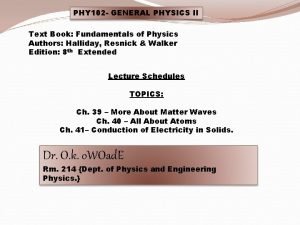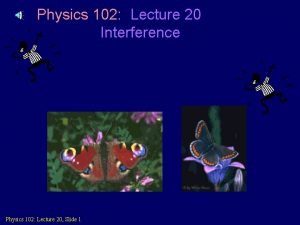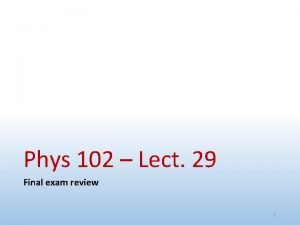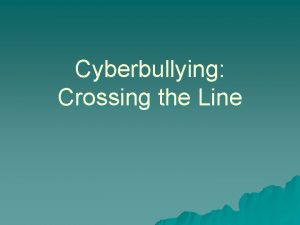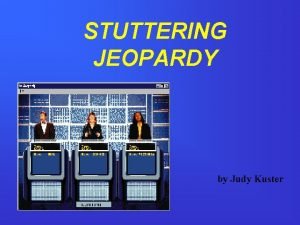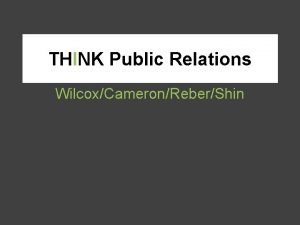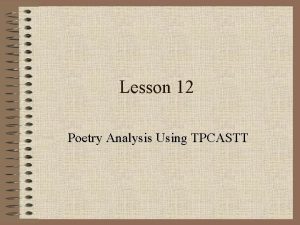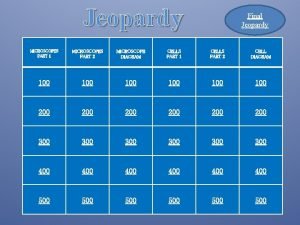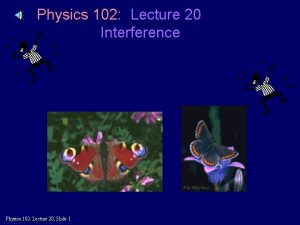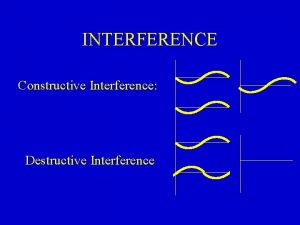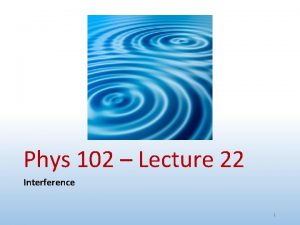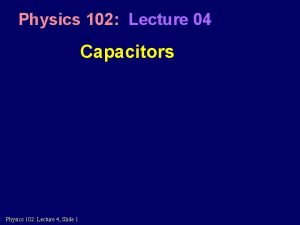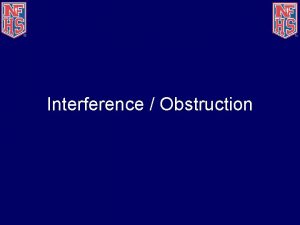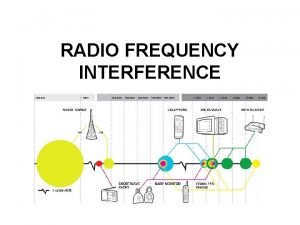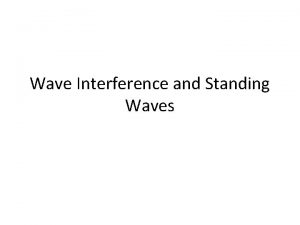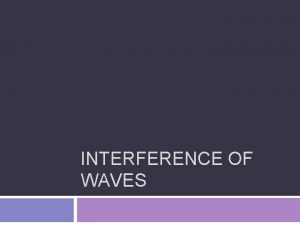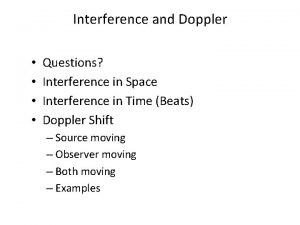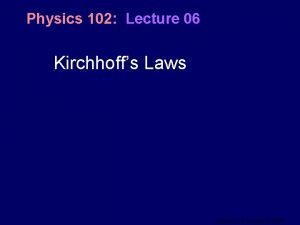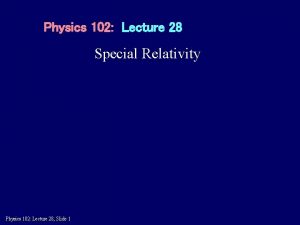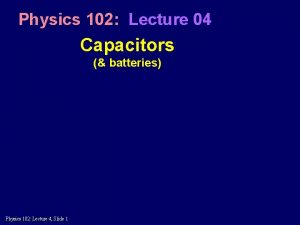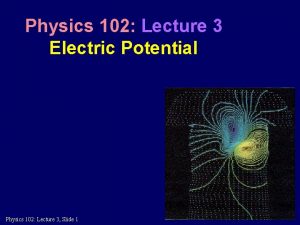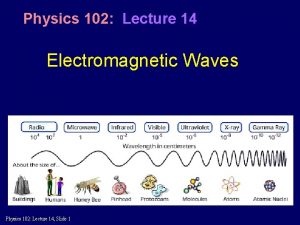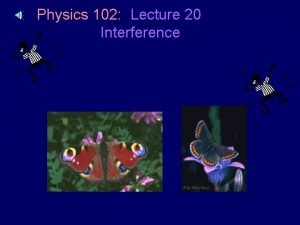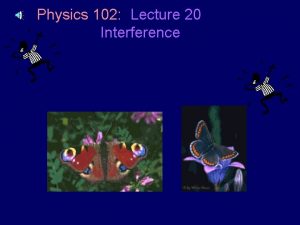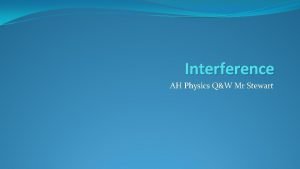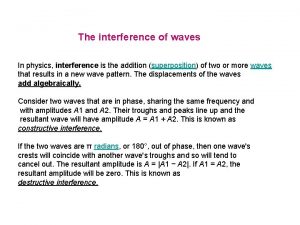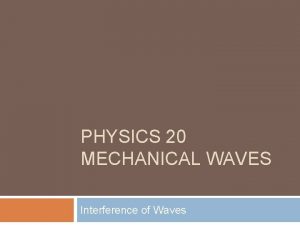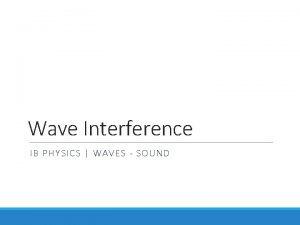Physics 102 Lecture 20 Interference Todays Lecture will


































- Slides: 34

Physics 102: Lecture 20 Interference • Today’s Lecture will cover textbook sections 25. 1, 3 -4 Physics 102: Lecture 20, Slide 1

Superposition Constructive Interference +1 -1 t + +1 -1 In Phase t +2 t -2 Physics 102: Lecture 20, Slide 2

Superposition Constructive Interference +1 -1 t + +1 -1 In Phase t +2 t -2 Physics 102: Lecture 20, Slide 3

Superposition Destructive Interference +1 -1 t + +1 -1 Out of Phase t +2 t -2 Physics 102: Lecture 20, Slide 4 180 degrees

Superposition Destructive Interference +1 -1 t + +1 -1 Out of Phase t +2 t -2 Physics 102: Lecture 20, Slide 5 180 degrees

Superposition ACT + Different f 1) Constructive Physics 102: Lecture 20, Slide 6 2) Destructive 3) Neither

Superposition ACT + Different f 1) Constructive Physics 102: Lecture 20, Slide 7 2) Destructive 3) Neither

Interference Requirements • Need two (or more) waves • Must have same frequency • Must be coherent (i. e. waves must have definite phase relation) Physics 102: Lecture 20, Slide 8

Interference for Sound … For example, a pair of speakers, driven in phase, producing a tone of a single f and : hmmm… I’m just far enough away that l 2 l 1= /2, and I hear no sound at all! l 1 l 2 But this won’t work for light--can’t get coherent pair of sources Physics 102: Lecture 20, Slide 9

Interference for Light … • Can’t produce coherent light from separate sources. (f 1014 Hz) • Need two waves from single source taking two different paths – Two slits – Reflection (thin films) – Diffraction* Single source Two different paths Interference possible here

ACT: Young’s Double Slit Light waves from a single source travel through 2 slits before meeting on a screen. The interference will be: 1) Constructive 2) Destructive 3) Depends on L d Single source of monochromatic light 2 slitsseparated Physics 102: Lecture 20, Slide 11 by d L Screen a distance L from slits

ACT: Young’s Double Slit Light waves from a single source travel through 2 slits before meeting on a screen. The interference will be: JAVA 1) Constructive 2) Destructive 3) Depends on L d Single source of monochromatic light 2 slitsseparated Physics 102: Lecture 20, Slide 12 by d L The rays start in phase, and travel the same distance, so they will arrive in phase. Screen a distance L from slits

Preflight 20. 1 The experiment is modified so that one of the waves has its phase shifted by ½ l. Now, the interference will be: 1) Constructive ½ l shift 2) Destructive 3) Depends on L d Single source of monochromatic light 2 slitsseparated Physics 102: Lecture 20, Slide 13 by d L Screen a distance L from slits

Preflight 20. 1 The experiment is modified so that one of the waves has its phase shifted by ½ l. Now, the interference will be: 1) Constructive ½ l shift 2) Destructive 3) Depends on L d Single source of monochromatic light 2 slitsseparated Physics 102: Lecture 20, Slide 14 by d L The rays start out of phase, and travel the same distance, so they will arrive out of phase. Screen a distance L from slits

Young’s Double Slit Concept At points where the difference in path length is 0, , 2 , …, the screen is bright. (constructive) d Single source of monochromatic light 2 slitsseparated Physics 102: Lecture 20, Slide 15 by d At points where the difference in path length is L the screen is dark. (destructive) Screen a distance L from slits

Young’s Double Slit Key Idea L Two rays travel almost exactly the same distance. (screen must be very far away: L >> d) Bottom ray travels a little further. Key for interference is this small extra distance. Physics 102: Lecture 20, Slide 16

Young’s Double Slit Quantitative sin(θ) tan(θ) = y/L d d Path length difference = Constructive interference Destructive interference (Where m = 0, 1, 2, …) Physics 102: Lecture 20, Slide 17 d sin q

Young’s Double Slit Quantitative d d Path length difference = d sin q Constructive interference Destructive interference where m = 0, or 1, or 2, . . . Need l < d

Young’s Double Slit Quantitative L y d A little geometry… sin(q) tan(q) = y/L Constructive interference Destructive interference where m = 0, or 1, or 2, . . . Physics 102: Lecture 20, Slide 19

Preflight 20. 3 L y d When this Young’s double slit experiment is placed under water. The separation y between minima and maxima 1) increases Physics 102: Lecture 20, Slide 20 2) same 3) decreases

Preflight 20. 3 L y d When this Young’s double slit experiment is placed under water. The separation y between minima and maxima 1) increases 2) same …wavelength is shorter under water. Physics 102: Lecture 20, Slide 21 3) decreases

Preflight 20. 2 In the Young’s double slit experiment, is it possible to see interference maxima when the distance between slits is smaller than the wavelength of light? 1) Yes Physics 102: Lecture 20, Slide 22 2) No

Preflight 20. 2 In the Young double slit experiment, is it possible to see interference maxima when the distance between slits is smaller than the wavelength of light? 1) Yes Need: d sin q = m l If l>d 2) No => sin q = m l / d then l/d>1 so sin q > 1 Not possible! Physics 102: Lecture 20, Slide 23

Thin Film Interference 1 2 t n 0=1. 0 (air) n 1 (thin film) n 2 Get two waves by reflection off of two different interfaces. Ray 2 travels approximately 2 t further than ray 1. Physics 102: Lecture 20, Slide 24

Reflection + Phase Shifts Incident wave Reflected wave n 1 n 2 Upon reflection from a boundary between two transparent materials, the phase of the reflected light may change. • If n 1 > n 2 • If n 1 < n 2 Physics 102: Lecture 20, Slide 25

Reflection + Phase Shifts Incident wave Reflected wave n 1 n 2 Upon reflection from a boundary between two transparent materials, the phase of the reflected light may change. • If n 1 > n 2 - no phase change upon reflection. • If n 1 < n 2 - phase change of 180º upon reflection. (equivalent to the wave shifting by /2. ) Physics 102: Lecture 20, Slide 26

Thin Film Summary Determine d, number of extra wavelengths for each ray. 1 2 n = 1. 0 (air) n 1 (thin film) t n 2 This is important! Reflection Distance Ray 1: d 1 = 0 or ½ Ray 2: d 2 = 0 or ½ + 2 t/ lfilm If |(d 2 – d 1)| = 0, 1, 2, 3 …. If |(d 2 – d 1)| = ½ , 1 ½, 2 ½ …. Physics 102: Lecture 20, Slide 27 Note: this is wavelength in film! (lfilm= lo/n 1) (m) constructive (m + ½) destructive

Thin Film Practice 1 2 t n = 1. 0 (air) nglass = 1. 5 nwater= 1. 3 Blue light (lo = 500 nm) incident on a glass (nglass = 1. 5) cover slip (t = 167 nm) floating on top of water (nwater = 1. 3). Is the interference constructive or destructive or neither? d 1 = d 2 = Phase shift = d 2 – d 1 =

Thin Film Practice 1 2 t n = 1. 0 (air) nglass = 1. 5 nwater= 1. 3 Blue light (lo = 500 nm) incident on a glass (nglass = 1. 5) cover slip (t = 167 nm) floating on top of water (nwater = 1. 3). Is the interference constructive or destructive or neither? Reflection at air-film interface only d 1 = ½ d 2 = 0 + 2 t / lglass = 2 t nglass/ l 0= 1 Phase shift = d 2 – d 1 = ½ wavelength

ACT: Thin Film Blue light l = 500 nm incident on a thin film (t = 167 nm) of glass on top of plastic. The interference is: (1) constructive (2) destructive (3) neither d 1 = d 2 = Phase shift = d 2 – d 1 = Physics 102: Lecture 20, Slide 31 1 2 t n=1 (air) nglass =1. 5 nplastic=1. 8

ACT: Thin Film Blue light l = 500 nm incident on a thin film (t = 167 nm) of glass on top of plastic. The interference is: (1) constructive 1 2 t (2) destructive n=1 (air) nglass =1. 5 nplastic=1. 8 (3) neither d 1 = ½ Reflection at both interfaces! d 2 = ½ + 2 t / lglass = ½ + 2 t nglass/ l 0= ½ + 1 Phase shift = d 2 – d 1 = 1 wavelength Physics 102: Lecture 20, Slide 32

Preflights 20. 4, 20. 5 A thin film of gasoline (ngas=1. 20) and a thin film of oil (noil=1. 45) are floating on water t= (nwater=1. 33). When the thickness of the two films is exactly one wavelength… The gas looks: • bright • dark Physics 102: Lecture 20, Slide 33 nair=1. 0 ngas=1. 20 noil=1. 45 nwater=1. 3 The oil looks: • bright • dark

Preflights 20. 4, 20. 5 A thin film of gasoline (ngas=1. 20) and a thin film of oil (noil=1. 45) are floating on water t= (nwater=1. 33). When the thickness of the two films is exactly one wavelength… The gas looks: • bright • dark d 1, gas = ½ d 2, gas = ½ + 2 | d 2, gas – d 1, gas | = 2 constructive Physics 102: Lecture 20, Slide 34 nair=1. 0 ngas=1. 20 noil=1. 45 nwater=1. 3 The oil looks: • bright • dark d 1, oil = ½ d 2, oil = 2 | d 2, oil – d 1, oil | = 3/2 destructive

See you later! • Read Textbook Sections 25. 5 - 25. 9 Physics 102: Lecture 20, Slide 35
 Retroactive vs reactive
Retroactive vs reactive Retrospective interference
Retrospective interference Interference of light engineering physics
Interference of light engineering physics Physics 102
Physics 102 Physics 102 electricity and magnetism
Physics 102 electricity and magnetism Physics 102
Physics 102 Physics 102
Physics 102 Physics 102 uiuc
Physics 102 uiuc Physics 102
Physics 102 Physics 102
Physics 102 Physics 102
Physics 102 Physics 102 final exam
Physics 102 final exam 01:640:244 lecture notes - lecture 15: plat, idah, farad
01:640:244 lecture notes - lecture 15: plat, idah, farad Physics 101 lecture 1
Physics 101 lecture 1 Physics 101 lecture
Physics 101 lecture Physics 101 lecture notes pdf
Physics 101 lecture notes pdf Waves physics pdf
Waves physics pdf Classical mechanics
Classical mechanics Atmospheric physics lecture notes
Atmospheric physics lecture notes Todays objective
Todays objective Welcome to sabbath school
Welcome to sabbath school Todays objective
Todays objective Famous people with prader willi syndrome
Famous people with prader willi syndrome Todays worldld
Todays worldld Adam smith jeopardy
Adam smith jeopardy Todays objective
Todays objective Conclusion of digestive system
Conclusion of digestive system Todays vision
Todays vision Todays jeopardy
Todays jeopardy Chapter 13 marketing in today's world
Chapter 13 marketing in today's world Todays generations
Todays generations Today meeting or today's meeting
Today meeting or today's meeting Today's public relations departments
Today's public relations departments Todays agenda
Todays agenda 3 statements of cell theory
3 statements of cell theory

